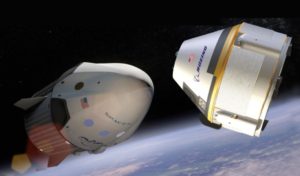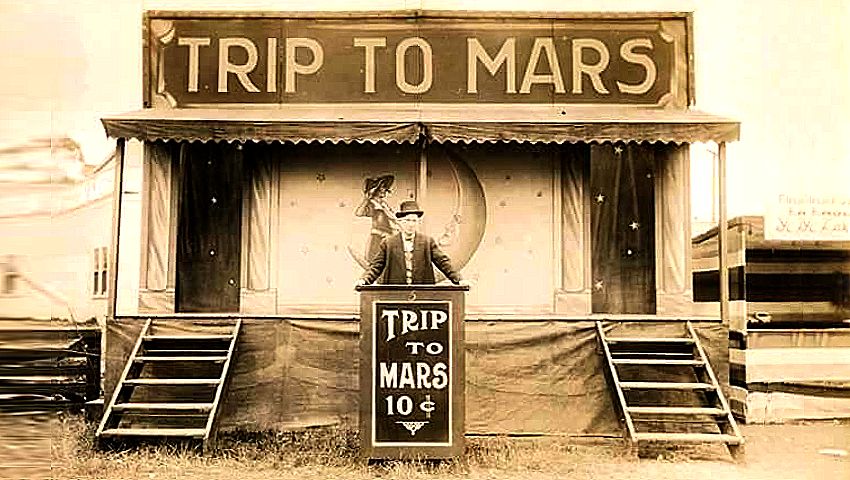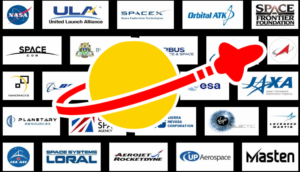Contents
100 years ago the ancestors of Bigelow, Bezos or Musk may not have had the benefit of government money when peddling their wares. However one attribute they would have shared with their modern day descendants would have been just as useful – great showmanship.
Just like NASA (in their day) and other national agencies, in 2018 the NewSpace sector is looking to not only achieve some amazing things, but to tell their story in a way that illustrates through their endeavours, they are ready to take the helm, or are commercially viable (potentially), or at least worth following and reporting on.
2017 not only saw the start of Donald Trump’s presidency and marked a record breaking period of the still headless US space agency clambering about in the dark without a leader but was also another cold and harsh year for NASA’s publicists and marketers of the SLS/Orion projects. Those guys have had it hard. So hard that many can understand why they are holding back from facing the flack these expensive projects attract from all angles. Ready to fight another day – just not yet.
Hell in commercial space. 2017 finally killed XCOR, their website still displaying the corpse and all the signs of desertion by those staffers who were forced to abandon ship. The year also saw Virgin Galactic’s chiefs launch, not a spaceplane but a whole new brand ready to accommodate the next cohort of investors – already lined up and ready to go. And then there is Musk.
 Despite their leader’s fun relationship with deadlines, SpaceX’s marketing team are always in top form with plenty of material to shout about to the brand’s always growing “fanbase”. From publicising hush hush trips to the Moon for, well, hopefully anyone with their check books at the ready, to creating a bfr (big fucking racket) about Falcon Heavy’s untimely maiden voyage which will shoot Elon’s car “to Mars” (or at least to Mars orbit now that Mars is no longer there) – 2018 is going to be quite a ride.
Despite their leader’s fun relationship with deadlines, SpaceX’s marketing team are always in top form with plenty of material to shout about to the brand’s always growing “fanbase”. From publicising hush hush trips to the Moon for, well, hopefully anyone with their check books at the ready, to creating a bfr (big fucking racket) about Falcon Heavy’s untimely maiden voyage which will shoot Elon’s car “to Mars” (or at least to Mars orbit now that Mars is no longer there) – 2018 is going to be quite a ride.
So, here we run through some of the most likely stories we have heared we will be reading about on all our favourite space news websites over the coming year – Including a number of the usual annual “projected milestones” and “possible breakthroughs” claimed by those good ole marketers of brands known to enjoy more mouth than trousers.
More collaboration from the government space agencies
Initially, top players in the space environment (who are still mostly government agencies) competed aggressively against each other to establish their dominance in the space frontier. However, the aggressive competition has somewhat died down of late, with several nations combining their efforts in order to make even more significant achievements.
Good examples of previous collaboration between countries include the setting up of the International Space Station and the formation of the European Space Agency. However with more and more pressure to cease NASA’s funding of the Space Station a growing number of players are advocating continued support beyond it’s planned shutdown in 2024. So it’s likely we will har more support for extending the station’s life from all corners of the globe over the coming months and years.
In 2018, you can expect to see more collaboration between the major players in the space sector, especially with the planned construction of a new space station near the moon. The new space station project is expected to be constructed by both Russia and the US, although several other countries with interests in space are likely to join.
 Collaboration in the final frontier is not only limited to government space agencies however. For a while now, several government space agencies around the world have been working with private space companies to achieve more results in space. A good example is NASA’s joint space projects with local private space companies such as SpaceX and Boeing.
Collaboration in the final frontier is not only limited to government space agencies however. For a while now, several government space agencies around the world have been working with private space companies to achieve more results in space. A good example is NASA’s joint space projects with local private space companies such as SpaceX and Boeing.
As expected, in 2018 we are sure to see more of this joint effort even if those ‘anti-marketers’ following the money continue to generate claims that the U.S. government exploit space projects as pork barrel rides in exchange for votes.
Increased competition between private space companies
Another highlight in the space industry in the past number of years has been the increase of private space companies. However, the increase in the number of these new players has also led to a new space race dubbed the private space race.
 The result of the private space race has been heated competition between private space companies, especially those with the main objectives. A good example is the competition between SpaceX and Boeing, with each company seeking to be the first commercial firm to fly NASA’s astronauts to the ISS.
The result of the private space race has been heated competition between private space companies, especially those with the main objectives. A good example is the competition between SpaceX and Boeing, with each company seeking to be the first commercial firm to fly NASA’s astronauts to the ISS.
Since the company that wins this contest will most likely end up with an exclusive government contracts that could be worth several billions of dollars, the competition has become aggressive to the point that some companies have publicly put their rivals on notice. It is notable though that these high-level manoeuvres are handled by seasoned leaders and are taken out of the hands of lowly company publicists and social media marketers – known for creating the odd pr disaster.
In 2018, this rivalry is likely to reach a new height as the companies draw closer to realizing some of their set objectives, for example, building towards manned lunar missions, manned Mars exploration missions, space tourism, and more.
Increased militarization of low-Earth orbit and beyond
Another unfortunate trend is the militarization of the space frontier, where several companies have invested heavily in military space projects and launch vehicles.
 However, some countries have gone as far as trying to start weaponizing space in an effort to gain an edge over their rivals. A recent example is China, which has come under heavy criticism in the past for their counter space program, which has developed anti-satellite systems that can target and take down other countries’ space assets. Other countries also suspected or rumored to have space weapons include the US, Russia and now North Korea.
However, some countries have gone as far as trying to start weaponizing space in an effort to gain an edge over their rivals. A recent example is China, which has come under heavy criticism in the past for their counter space program, which has developed anti-satellite systems that can target and take down other countries’ space assets. Other countries also suspected or rumored to have space weapons include the US, Russia and now North Korea.
In 2018, the militarization of the space frontier is expected to increase, as more and more countries discover the benefits of military space assets – or are coaxed into investing in them anyways. The increased hostility and mistrust among some countries is also likely to cause an increase in both militarization and weaponization of space.
Most of the stories about these projects will be spun as defensive projects or the marketing and pr guys will just step back for a while, as in the case of Zuma and other secret satellites used for surveillance, reconnaissance, and secure communications by military and law enforcement agencies.
More investment from existing NewSpace companies
The benefits of space exploration are many: more affordable and accessible communications, discovery of new educational information, military benefits, creation of jobs, minerals and raw materials, and prestige (for countries and companies operating in space). More and more investors are supporting new and existing companies realize how important the space frontier can be, leading them to invest heavily in the industry.
In 2018, the investment in the space sector is expected to increase significantly, and too are the column inches, with entry of new players along with existing space firms:
Planetary Resources
 Will 2018 be the year Planetary resources fulfill their marketing proposition to “fuel industry and sustain life in space” by mining near-Earth asteroids of their rich resources? Urr, well no. That might take a few years more to achieve just yet but their public relations guys are getting good at digging deep for marketing materials that keeps us staying tuned. After all January 2018 saw the launch of their Arkyd-6 spacecraft into orbit, ready to capture their first mid-wave infrared images. Don’t worry, as soon as they get their sights on exo-gold, you’ll hear all about it.
Will 2018 be the year Planetary resources fulfill their marketing proposition to “fuel industry and sustain life in space” by mining near-Earth asteroids of their rich resources? Urr, well no. That might take a few years more to achieve just yet but their public relations guys are getting good at digging deep for marketing materials that keeps us staying tuned. After all January 2018 saw the launch of their Arkyd-6 spacecraft into orbit, ready to capture their first mid-wave infrared images. Don’t worry, as soon as they get their sights on exo-gold, you’ll hear all about it.
Virgin Galactic
To the surprise of many… Virgin Galactic will fly! Not their SpaceShipTwo of course, but the LauncherOne vehicle they recently adapted from a 747 Jumbo. Superstar publicist Sir Richard will have many people sitting on the edge of their seats in 2018 for sure, even if its just to make space for more passengers on their now mythical forthcoming suborbital (‘space’) flights. Tickets to ride aboard SpaceShipTwo cost $200,000. Some 370 customers have plunked down deposits totaling $50 million.
Sierra Nevada
Sierra Nevada’s Dreamchaser won’t be going as far as the ISS in 2018 but their marketing machine will likely be bubbling (us) over with excitiemnt as they continue keeping us on the boil by dropping the thing in full view of the cameras and back to Earth – so dammit, watch this space.
Blue Origin
 Blue Origin are likely to start construction of their New Glenn rocket at Kennedy Space Center though. Blue’s spokespeople are predicting a 2020 launch. So Jeff Bezos and his merry men will have to start building, and of course publicising the first New Glenn sometime this year.
Blue Origin are likely to start construction of their New Glenn rocket at Kennedy Space Center though. Blue’s spokespeople are predicting a 2020 launch. So Jeff Bezos and his merry men will have to start building, and of course publicising the first New Glenn sometime this year.
Also, Blue Origin’s director of safety and mission assurance, Jeff Ashby said in December 2017 that New Shepard is “about roughly a year out from human flights, depending on how the test program goes.”
SpaceX
As mentioned previously, the big event we all hope to see in 2018 will be SpaceX launching two paying customers on a flight around the moon. Sure Elon Musk knows deadlines don’t matter jot compared to the significance of the event and the story it generates. However it will only happen in 2018 if the first Falcon Heavy flies successfully and the manned Dragon 2 flight to the space stations lifts off on time.
Bigelow
Despite the above progress and predictions, Robert Bigelow and his team have now been waiting for over a decade for a service that can get his commercial crew customers into low-Earth orbit. Is this going to the year reporters get to announce he makes rather than spends a shed load of money? Don’t hold your breath Bob, 2018 could be yet another year where one or more NewSpace firms fills you with hot air or bursts your bubble.
How will space news journalists market their stories
 Once they have been made great again, Will the republic of the United States, with it’s tradition of political dynasties and love of honours hand it’s first space knighthood to the all seeing Jeff Foust? Probably not, will NASAwatch allow those who comment on their website to slate NASA’s forthcoming administrator before he gets into office or start to hold back from attacking CASIS?. Not likely.
Once they have been made great again, Will the republic of the United States, with it’s tradition of political dynasties and love of honours hand it’s first space knighthood to the all seeing Jeff Foust? Probably not, will NASAwatch allow those who comment on their website to slate NASA’s forthcoming administrator before he gets into office or start to hold back from attacking CASIS?. Not likely.
Maybe Space.com will focus on delivering more space sector news rather than sci-fi product placement and star trek franchise filler materials, and will spacedaily’s flow of news dry up so much that other space news sites have to go out looking for their own stories elsewhere. Nah it’s just not going to happen. Well not in 2018 anyway.
One thing is for sure though, despite Denis Tito becoming a paying space adventurer way back in 2001, countless space and non-space journalists will claim the title of “first space tourist” for Bezos or Musk in 2018 and like good ole Erasmusk said way back before the days of the moondust goldrush… it really is like de ja vu all over again, history repeats itself with plenty of same old, same old, exciting times ahead!







![Yikes! Apparently people have been making Uranus jokes at least since this 1881 edition of the satirical magazine Puck.
[Found by Elizafox System on Mastodon]](https://pbs.twimg.com/media/FwWGy-DWAA4v1SQ.jpg)
